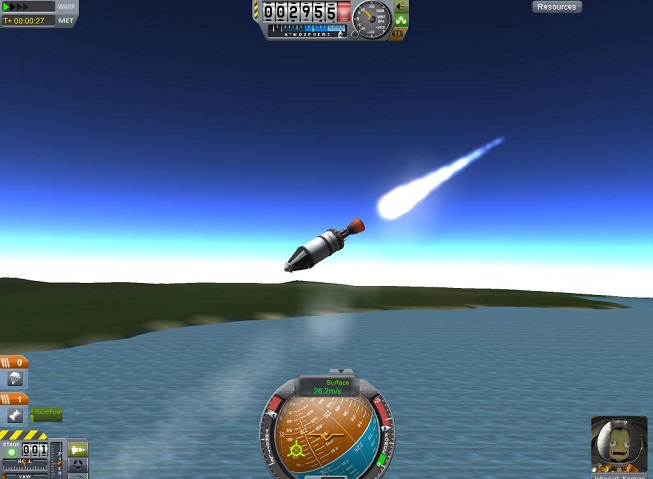Part 1: Mission: Ascender-1

This is the home of the Kerbal Space Program. Most of it is underground, for safety reasons. What is above ground in this facility is a tracking station, the Vehicle Assembly Building where the rockets are actually built, the launchpad itself, and a hangar with runway that is only used for support aircraft now but has the potential for "spaceplane" flights.
When I arrived at the base, I wondered why so many tunnels, shelters, and bunkers had to be built. The ground crews laughed at my ignorance, then looked frightened. Our first manned flight showed that me and my staff had reason to be worried.

This was the modest rocket that marked our first trip upwards. Ascender-1, the first piloted flight, and the first deployment of a complete spacecraft system of capsule, engine, and parachute. Jebediah Kerman, one of the most fearless pilots of the academy class, sat at the controls. As the live camera showed, he was quite eager to get started.

This is a view from the seat of the instruments in the capsule's interior. That one could even potentially control a spacecraft with them is extremely remarkable to this program administrator's eyes, especially given the most daunting element of the capsule.

This small window is the only view outside the pilot has, making the instruments and a good ground control all the more essential for successful maneuvering. The capsule is not exactly an acrobatic biplane, but it and its successors will still need to be steered.

Ascender-1 had nowhere near the fuel necessary to make it to space. Its intended mission for this flight was to burn until its fuel ran out, follow a ballistic arc, then deploy the parachute and splash down. For the first several seconds of flight, it appeared to be on course.

Then, just after T+10 seconds, it began to spin out of control. Jebediah remained exuberant throughout the spin, and while some of the ground crew insisted that the engine be cut immediately, the pilot refused, insisting that it'd be safer to burn off all the fuel before touching down.

The parachute deployed flawlessly, and Ascender-1 descended smoothly for a land touchdown on the space center's property.

Unfortunately, the actual landing was not as smooth, the engine being destroyed upon contact. Even the maniacally cheerful Jeb was freaked by that incident. We were too, with one hysterical technician claiming the capsule was destroyed before the smoke cleared.

Jeb was able to exit and leap free from the capsule as his emergency training had taught him. A ground crew rushed him back to the infirmary, where he was found to have very minor wounds and a strong urge to "do it again". Ascender-1 was taken in for post-flight inspection. The fuel tank was not breached, but Jeb's decision was still prescient.
The flight of Ascender-1 lasted for a minute and forty-one seconds from launch to landing. The ignonimous first flight of the Kerbal Space Program was a failure in that its objective was not achieved and the capsule lost control. However, it was also a success in some ways. The failure was not fatal, and the pilot and ground crew performed well in the emergency. The most pressing concern after Ascender-1 is the need to stabilize and control the spacecraft on future launches.
As I examined the report of the Ascender-1 mission, I realized why the program crew had such a literal bunker mentality. The thought of a larger, multi-stage rocket going wrong like Ascender-1 did is not a pleasant one.